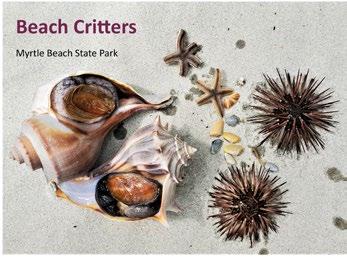
3 minute read
State Parks Adjust to New Normal
By: Dawn Dawson-House, Director of Corporate Communications, SC Department of Parks, Recreation & Tourism
Like most businesses and facilities, South Carolina state parks adjusted to a new normal under the Coronavirus pandemic. Not only did they follow protocols set by the SC Department of Health and Environmental Control, they also closed properties for one month as the state came to terms with the challenge it was facing. State parks began its retreat from COVID-19 in March by closing its group-gathering spaces like community buildings, wedding venues and picnic shelters. Within a week, the Park Service also closed campgrounds as it adjusted to new health and safety standards. The goal was to keep open space available to the growing number of people who were seeking social distancing options but limit visitation at places where groups tend to gather. Throughout the month of April, however, after Governor Henry McMaster issued executive orders to stay at home or work, all of South Carolina’s 47 state park properties were closed. This was especially challenging because two of the most popular seasons for state park campgrounds fell in the month of April this year – the Easter holiday week and public school spring break. In addition to a $3.5 million loss in revenue for a typical April, the Park Service also refunded about $2.5 million in rental reservations. Nonetheless, the Park Service remained engaged with this customer base. Instead of opening its campgrounds, the Park Service hosted a virtual Easter Egg Hunt on its website, inviting families to find “hidden eggs” within its pages. Later in April, the


Park Service hosted a virtual campout with the National Park Service and U.S. Forest Service, inviting people to camp in their own back yards and follow demonstrations on how to pitch a tent, make s’mores and enjoy many other activities. The Park Service also offered virtual interpretive events on Facebook Live several times per week beginning in mid March. Naturalists and interpreters showcased the types of wildlife that can be found on parks. The series had reached more than 852,000 people, garnered more than 332,000 video views and more than 20,000 post reactions. Although not part of the Facebook Live series, the May 1 Parks re-opening video “Pass the Keys” reached more than 1.6 million people and had more than 932,000 video views, 69,000 reactions and 9,000 comments. It was shared more than 14,000 times When state parks reopened to day-use on May 1, campgrounds were scheduled to open one week later with a few adjustments: • Visitors had to wear masks if they were going to interact with park staff • Park stores and gift shops operated under smaller, limited capacity and had plexiglass partitions installed at registers • Bathhouses and restrooms were sanitized more frequently • Everyone was encouraged to social distance, wash hands often and use hand sanitizer • No gatherings of more than 50 people were allowed in picnic shelters or other group gathering spaces With these new standards in place, state parks opened up to large crowds and high demand. Coastal parks that usually reach capacity five or six times every year were doing so almost every weekend in May, June and July. Inland parks that had rarely closed gates due to high visitation – like Paris Mountain in Greenville, Table Rock in Pickens and Givhans Ferry near Walterboro – were closing gates by early afternoon. State parks in South Carolina continue to be busy almost every day as visitors and staff adjust to this new normal.










